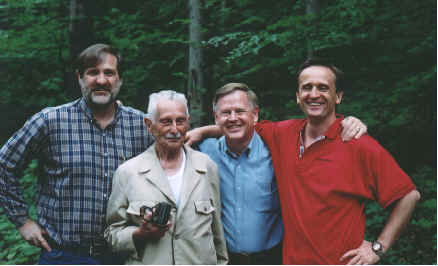Walter Bitterlich
|
This summer Kim Iles, Chris Cieszewski and Dave Marshall flew to Salzburg to visit Walter Bitterlich and to record him on video for historical purposes. Eventually, we will get around to editing the film. For now, the important thing is that we have about 15 hours of Bitterlich “in the can” to record some of the historical details.
Last year, Vienna University made an excellent short film of him (about 8 minutes) to celebrate his contributions to forestry and to Austria. We wanted to get something more technically substantial. After filming his home, he insisted that we climb up the Kaputzinerburg (the hill/park in the middle of Salzburg). Walter, at 92, led us up about 800 vertical feet to the top, where he maintains a permanent sample plot. We later learned that he takes that hike every Sunday.
To film his instruments in the field, we went into the Blühnbach valley, where the Austrian emperor built his hunting lodge. Today it is owned by a wealthy American of German descent. The area forester, our host for the day, takes care of the surrounding forest and manages the hunting, for which the valley is famous.
We visited the Relascope factory, where Dr. Hesske (who developed Bitterlich’s instrument) has now turned over the business to his daughter. She and her family were gracious hosts during the week.
Of course we had to sample the city of Salzburg and its culture. The largest beer manufacturer in Salzburg began in 1492, and celebrated its 500th anniversary as the USA celebrated Columbus. Our hosts even found an opera concerning forestry for us to see.
It was a great trip. Each of us brought home a woodcarving as a gift from Walter Bitterlich to remember our time there. It was a treat to see a man so devoted to his craft, and who has been so active as an artist, scientist and inventor.
The house was full of tools and inventions that he had developed over the years. Every time we opened a drawer there was another story to hear.
For his earlier 90th birthday we had brought him a small book signed by many of you who are timber cruisers or forest inventory specialists. When we arrived we found that the book had been reproduced by color copier, and covered a large portion of his office wall.
We filmed Walter explaining (to Dave and Kim) how he first developed his method in Austria just after the war. The actual line of thinking was more complex than we had imagined it to be, and the key was a careful review of actual field data that he had gathered himself. There is nothing like getting the data (and getting it yourself) to understand how things work.
Walter is very fit. We may yet be reporting on his 100th birthday celebration. He has done sports all of his life, and exercises every day. Later this summer he goes to Switzerland for his annual ice dancing clinic (he took up ice dancing when he was 70).
He is certainly a man who loves numbers and ideas, and his discipline in maintaining records meant that we looked through and recorded the original papers of his scientific work and the original scale models of his inventions. He was always able to lay his hands on anything of interest in a few moments.
We noticed that he had a box of tennis balls in the corner. These are for juggling, as he explained (and demonstrated), which he does to maintain flexibility. He showed us his records on the number of times he caught the balls before he dropped one, and talked about how this data “described a normal curve.” How very typical of that fascinating man.
